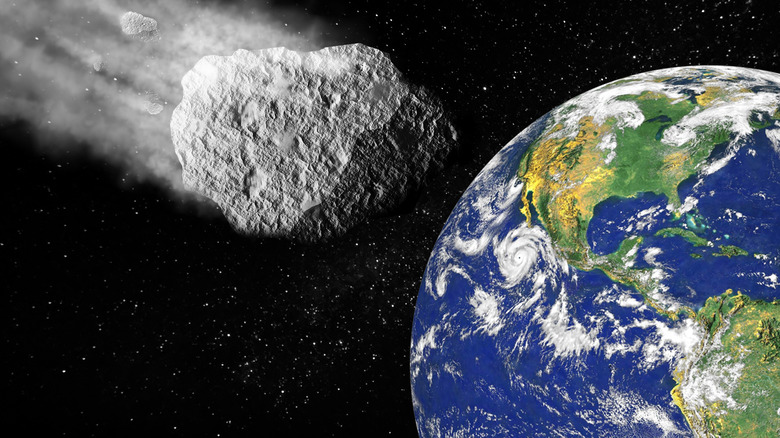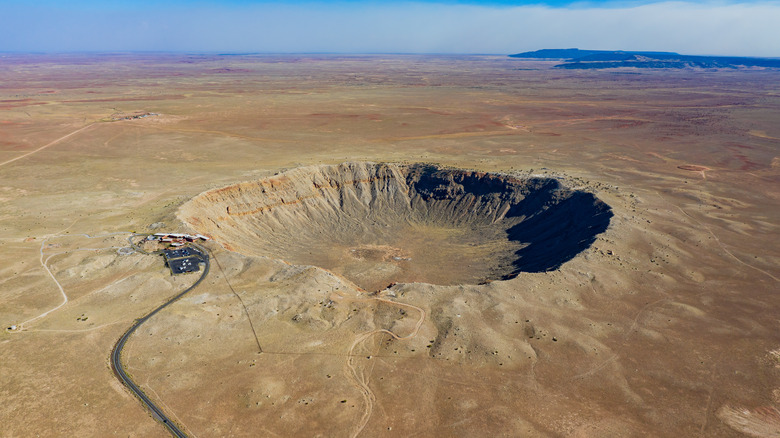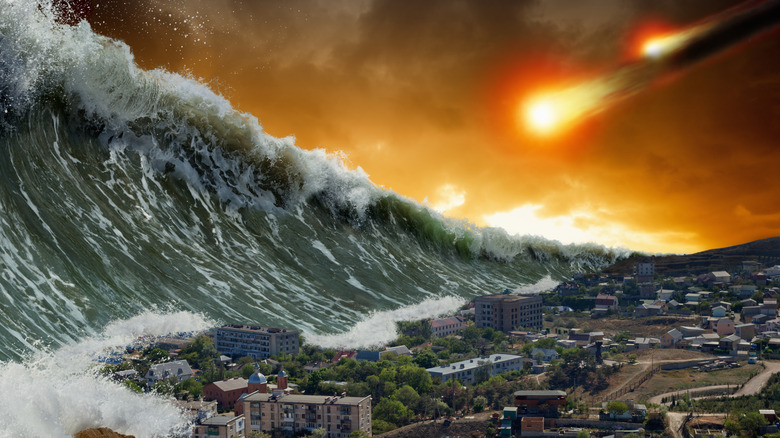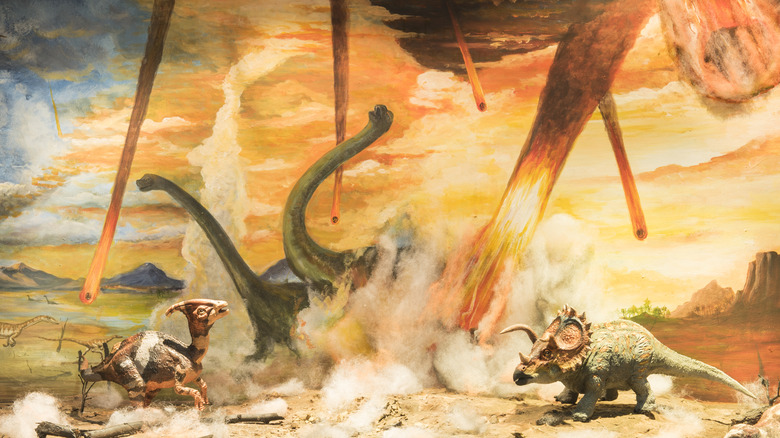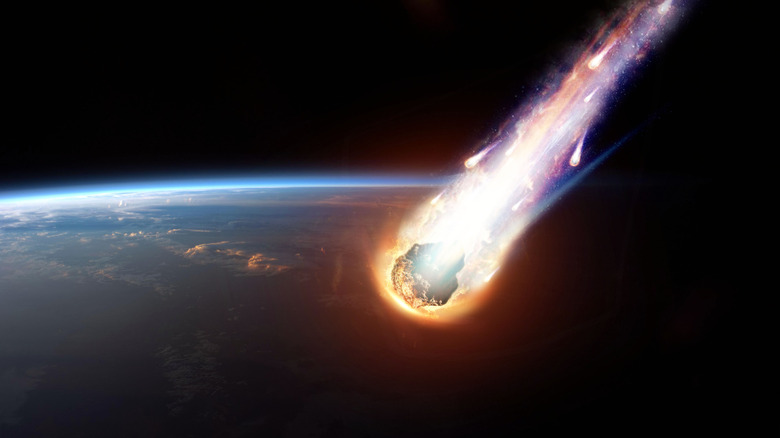Here's What Would Happen If Apophis Hit Earth
You may not have heard of 99942 Apophis, but you can rest assured that you'll be hearing quite a bit about it in the next few years. Specifically, you're likely to hear the name rather frequently as April 2029 approaches because that's when, according to EarthSky, the asteroid will pass close to Earth by the thinnest of razor-thin margins. Indeed, the space rock is expected to pass by at a distance of around 20,000 to 25,000 miles, or approximately one-tenth the distance between the Earth and the moon. To say that this is too close for comfort is an understatement.
A decade and a half ago, in 2004, scientific calculations actually predicted that there was a significant chance the asteroid would hit the Earth, according to NASA. Since then, observations and calculations have ruled out the possibility. However, considering that, had things shaken out differently in the dance between the Earth, Apophis, and the sun, the asteroid could very well have landed somewhere on our planet. And indeed, the three of us will continue that dance for the foreseeable future, and the day may come when Apophis and Earth finally do shake hands, and when that happens, it's unlikely to be good.
Understanding the size of Apophis
While most space rocks that reach the Earth's atmosphere burn up during entry due to friction, when an asteroid actually strikes the Earth, a variety of factors come into play that determines how much damage, if any, they do. Those factors include, but are not limited to, the size of the object, its mass, and the angle at which it enters the atmosphere.
As for the size and mass of Apophis, there's no real ambiguity about it. The object is estimated to be about 885 feet across (a hair smaller than the Eiffel Tower) and has a mass of 2.1 x 10 to the tenth power kg, according to Universe Today. If those figures are meaningless to you, here's a real-world example of what it all means: The asteroid that created Arizona's Meteor Crater (seen above) is believed to have exploded with the force between three and 10 megatons of energy. Should Apophis strike, it would likely deliver the equivalent of 880 megatons of energy. By comparison, the atomic bomb dropped on Hiroshima only released about 0.15 megatons of energy, according to Britannica.
Pray Apophis doesn't hit a populated area
Now that we know the damage that Apophis is capable of delivering, it's time to look into some real-world examples of what would happen when it hits. And it goes without saying that where it hits is going to play a role in how much damage it does.
According to Universe Today, wherever the asteroid hits (assuming it hits land), it's going to flatten thousands of square miles of land. If it hits a major city, like London, it's going to level the area, killing millions of people in the process.
If you think all of that sounds a bit hyperbolic, consider what happened to Hiroshima and Nagasaki. In both cases, a nuclear bomb delivering a fraction of the energy Apophis would likely release exploded over the cities, and about 200,000 people died as a result (according to Newsweek). Apophis would deliver significantly more magnitude of energy than either of the Hiroshima or Nagasaki weapons.
Fortunately, the odds of it hitting a populated area are small. In fact, the odds of it hitting land are small, considering that oceans cover about 75% of the Earth's surface. So statistically speaking, it's most likely that Apophis would land in the ocean.
Pray it doesn't land in the ocean, either
If you've ever thrown a rock into a placid lake, you've undoubtedly seen little ripples extending out in all directions. This displacement of water and the subsequent wave patterns it produces are all real-world examples of fundamental principles of physics that you can see every day.
Now imagine a giant rock (Apophis) hitting a giant lake (the ocean). It, too, is going to send out rippling waves in all directions, according to Universe Today. And those ripples are going to become devastating tsunamis, likely on multiple continents. Considering that a significant percentage of the human population lives in coastal cities, the death toll could be unimaginable. Strictly by way of example, scientist Neil deGrasse Tyson warned that a tsunami or series of tsunamis sparked by Apophis landing in the Pacific Ocean could wipe out the West Coast of the North America. "So what happens is, all the artificial stuff, all the houses, factories, they get churned into the ablative force that sandblasts the entire west coast of North America clean," Tyson said, per Express.
There probably won't be mass extinctions, however
Another consequence of an asteroid hitting the Earth is more long term than just the immediate devastation of major cities and coastlines. In some cases, asteroid impacts have kicked up so much dust and debris into the atmosphere that they cause climate change. Perhaps the most famous example of this is the so-called K-T asteroid impact which, according to the Planetary Science Institute, caused such drastic climate change that it led to the extinction of most of the dinosaurs, some 60 million years ago.
However, that asteroid was considerably larger than even Apophis. According to Universe Today, you shouldn't expect this particular space rock to kick up enough debris to cause long-term climate change. However, another expert, via Express, says climate change caused by an Apophis impact is a very real possibility. Clearly, the experts have different interpretations of this scenario.
However, it bears noting that not all climate changes created by naturally occurring phenomena wind up being devastating or long term. As NASA notes, volcanoes erupt all the time, causing brief disruptions in climate. Perhaps Apophis could cause a similar, short-term period of climate change.
There's absolutely nothing we can do about Apophis
We may know (or believe), thanks to observations and calculations, that we're almost certainly safe from Apophis when it zips by in 2029. But Apophis is just one Potentially Hazardous Object (PHO) out there in space, zipping across the solar system. There are thousands of these objects floating around out there. However, it turns out there is not a lot we can do about them. Further, as of now, any asteroid mitigation options are theoretical rather than real and operational.
According to Space.com, scientists are looking at a couple of ways to potentially interfere with an asteroid's path toward Earth. One involves putting up a barrier between the rock and the planet, with the hope of slowing the invader down just enough that the planet escapes danger. However, doing so would require multiple precise space missions in the span of a few months.
Similarly, according to Let's Talk Science, scientists are looking into slowing down a hazardous asteroid with lasers — again, just enough so that the Earth and the invader will miss each other.
Unfortunately, all of this is just theory, and no practical asteroid avoidance system exists or is even in the works. And it's a matter of when, not if, an Apophis-sized (or bigger) space rock enters this section of the solar system with Earth's name in its address bar.
